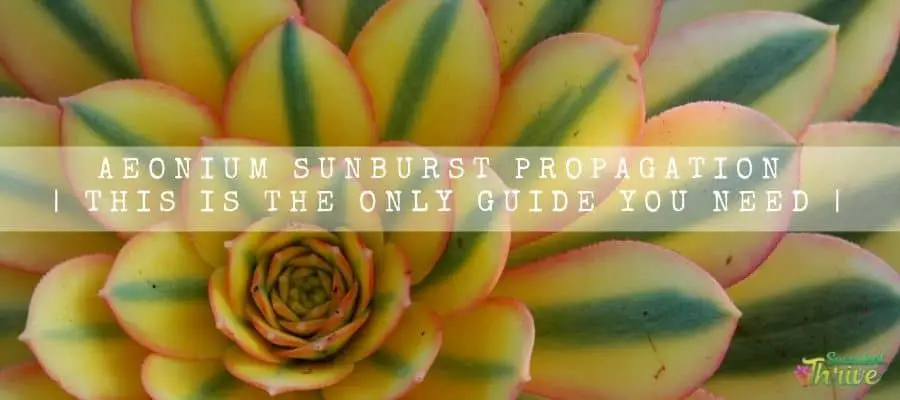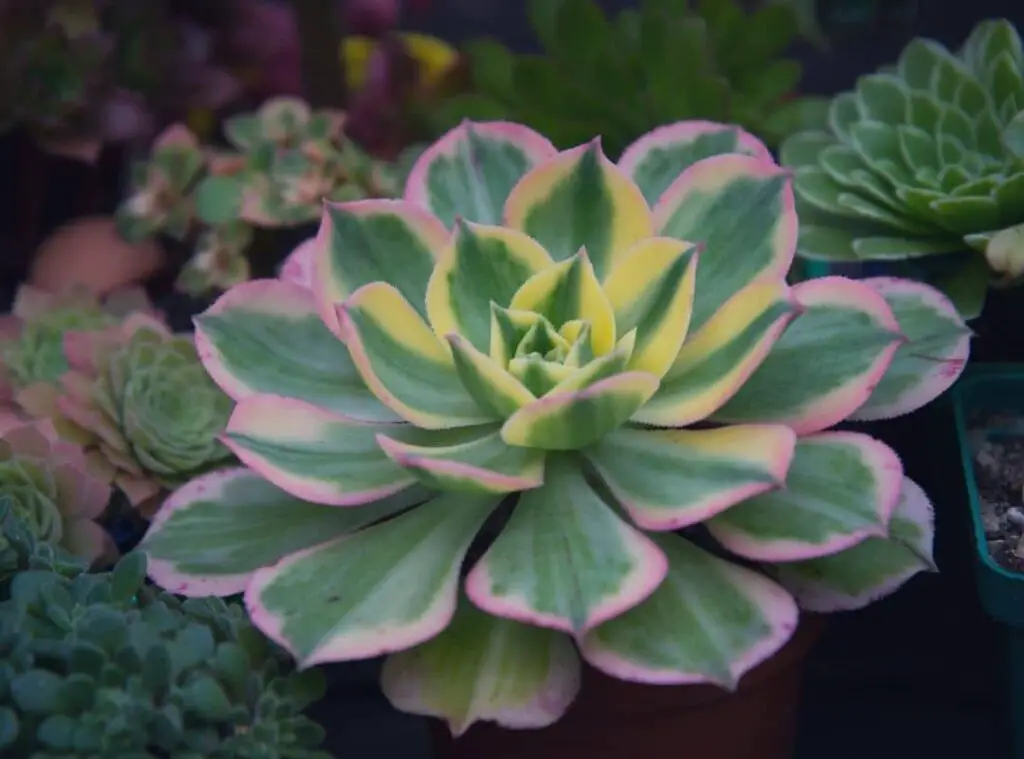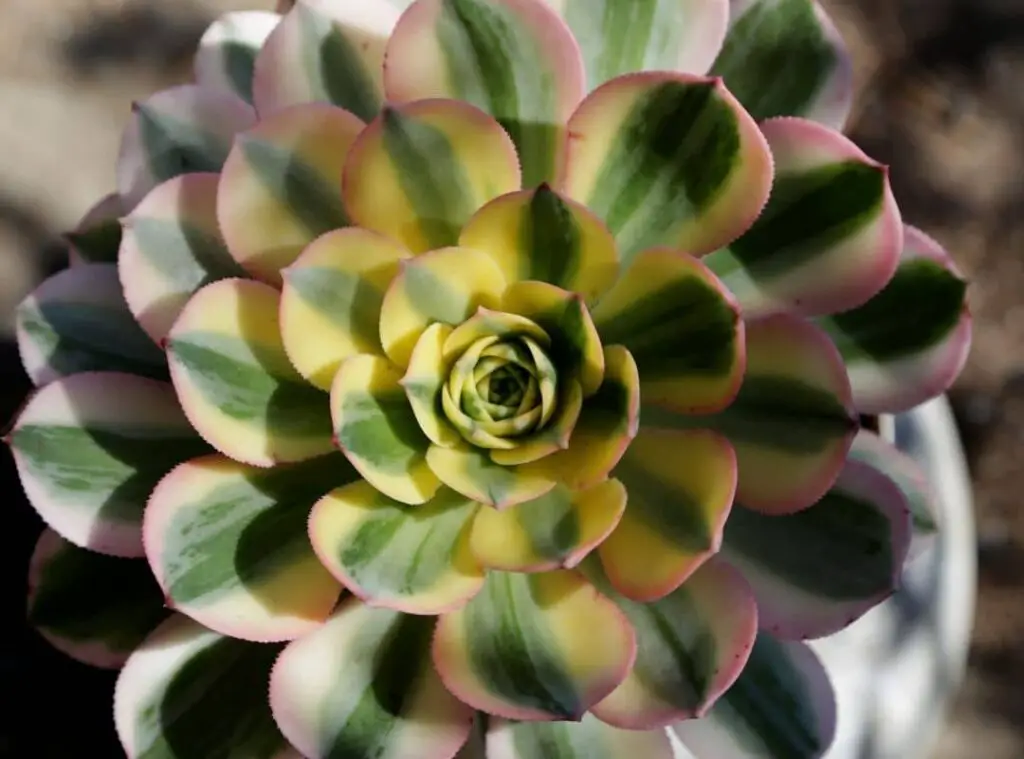You are here because you are interested in Aeonium sunburst propagation methods. So its my duty to provide meaningful information. Therefore I have collected these facts after a thorough research.
Please continue the reading and I am sure you will find the answer to your question here.

What is Aeonium sunburst?
Aeonium sunburst is commonly called sunburn Aeonium are fantastic succulent which you may come across if you are particularly into succulent gardening.
In fact, they are variegated plants which are mainly used for container gardening. Many people tend to grow them as container plants simply because they have an accent character.
Aeonium sunburst would be great picks for succulents’ gardens as well as for rock gardens. They will be the highlight of the garden simply due to the vibrant blue green colored foliage they have.
Aeonium sunburs are a variegated cultivator of Aeonium Davidbramwllii. In terms of their growing requirements, they have typical growing requirements just like the other succulents in general. However, these are monocarpic plants which usually die right after flowering.
Can you propagate an aeonium sunburst?
You can propagate Aeonium sunburst using their stem cuttings.
Aeonium sunburst propagation by Stem Cutting
One of the easiest ways of propagating the Aeonium sunburst is using the stem cutting method.
Aeonium sunburst are monocarpic plants which literally mean they perish right after flowering. When the plants are flowering, that would be the best time to obtain the cuttings to propagate them. Having said that, usually they take several years to bloom.
To propagate them, obtain the cuttings from mature plants whilst using a sterile knife or a pair of scissors.
When you make the cutting, ensure that you do it away from its cluster. Once you obtain the cuttings, you need to leave them somewhere where they can develop callous.
When you let them develop callous, it will reduce the probability of having any potential infection. Next you may go ahead with planting the cuttings in a soil mix which has excellent drainage. Continue watering them adequately until they become established.
Do they produce seeds?
Aeonium sunburst produces seeds. Further you may use them for the propagation process as well.
If you wish to use their seeds to propagate them, you simply have to plant them in a well-draining soil mix.
However, you need to maintain a temperature level of 19 -24 degrees Celsius (66 degrees – 75 degrees Fahrenheit) during this process.
You could place grow lights closer to these specimens until the germination takes place.

Can you root aeonium sunburst in water?
You could propagate the Aeonium sunburst in water. In fact, many people prefer to use the water propagation method rather than the soil propagation.
Literally you will be using the water as their growing medium when propagating the Aeonium sunburst through water propagation.
You may use the Aeonium sunburst stem cuttings to propagate them in water and you will have successful results with that.
How to treat after propagation
Sunlight requirement
Aeonium sunburst has a moderate requirement in terms of sunlight. The exposure for sunlight over six hours would be ideal for them.
Literally they can thrive well with full sunlight for six hours and partial shade during the rest of the day.
Hence either a bright sunny location in your garden or your bright sunny windowsill would be perfect for them to grow vigorously. The exposure for adequate sunlight will ensure that they become more vibrant in their colors.
Watering requirements
Aeonium sunburst’s water requirement is quite similar to other succulents and cactus in general. They would thrive well with moderate amounts of water.
They will prefer to have deep watering occasionally. Further when watering, ensure that the top layer of the soil mix is dry and only then you need to water them.
Water the plants well and ensure that excess water is moving through the draining holes.
Do not ever let any water pools remain in rosettes or in the pots as it would contribute to rot. These are quite responsive for over watering and you should not expose them for such conditions at any given time.
You need to minimize watering the Aeonium sunburst during cooler weather conditions. If you end up over watering during winter, it will cause many repercussions for the well being of the plants.

Soil requirements
A soil mix which has a greater component of organic matter would be more appropriate to grow the Aeonium sunburst plants.
In addition to that, having good drainage in the soil mix is also crucial when choosing the right soil mix to grow them. A soil mix which has a greater component of sand, peat moss would be ideal for them.
You may either purchase the right soil mix from stores or make a soil mix on your own too. If you wish to make a soil mix on your own, you need to mix balanced amounts of peat moss, perlite vermiculture and coarse sand.
Ensure that you are using a well-draining soil mix. Unless it would make the plants more prone towards root rot.
If you grow them in a poor draining soil mix, it will leave the plants roots in wet conditions which would be unhealthy for the plant’s growth.
Refrain from using clay soil as they are too heavy and will not be healthy for the plant’s growth. It will be convenient and easy if you grow them in a succulent soil mix or in a cactus soil mix.
Temperature and humidity
Aeonium sunburst can thrive well in root temperature and room humidity levels. A temperature range of 40 degrees Fahrenheit – 100 degrees Fahrenheit would go well with these plants.
Do not expose them to low temperatures such as 50 – 55 degrees Fahrenheit as it could contribute to a slow growth of the plants. Moreover, it would make the plants leggy too.
If we take humidity into consideration, they will thrive in the same humidity levels just like the other indoor plants.Literally Aeonium sunburst would grow well given that they get a humidity level of 30 % to 60 %.
Fertilizing
You may consider applying fertilizers for Aeonium sunburst plants as it would help them to have a firm and vigorous growth.
You could consider feeding them when they are actively growing. That will allow the plant’s roots to absorb nutrients well.
If you are wondering as to what type of fertilizer would go well with them, you could use a half strength balanced fertilizer which you dilute with water.
Finally
To wind up, trust you found this article useful and you were able to improve your knowledge on how to conduct the propagation properly and how to look after them well too. Happy gardening !
Read Next : Aeonium Arboreum Propagation (Now You Know How To Make More) 5 Effective Coral Cactus Propagation Methods Haworthia Cooperi Propagation Guide | 5 Effective Methods |
